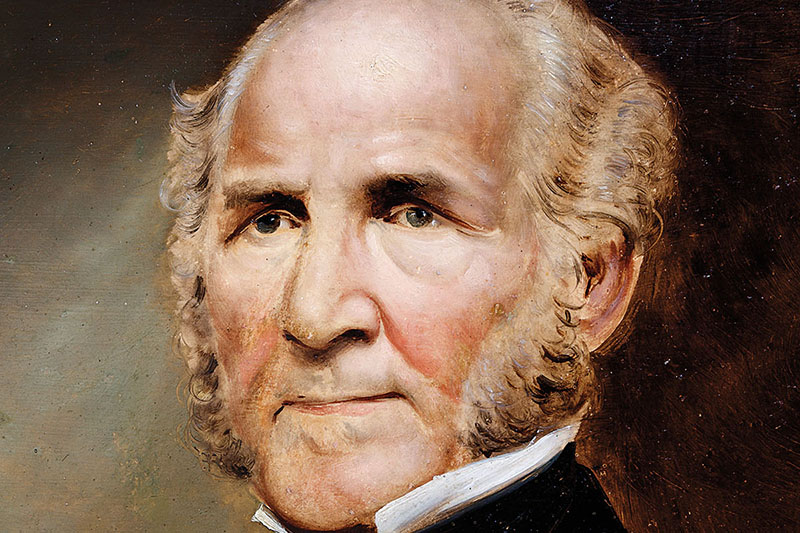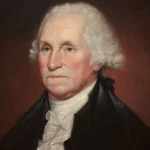
Portrait of Sam Houston Memorial Museum, Huntsville, Texas USA.
Sam Houston, a soldier and American politician, is renowned for making Texas a constituent state in the U.S. Born on March 2nd, 1793, in Virginia to Major Samuel Houston and Elizabeth Paxton, he grew up as the fifth of nine children in the family. Tragically, his father, a Revolutionary War veteran, passed away when Sam was just 14 years old, prompting the family to move to Tennessee. It was there that Sam formed a deep bond with the Cherokee Indians. Joining the U.S. Military, he crossed paths with Andrew Jackson, whose inspiration led him to pursue a career in politics. Remarkably, Sam Houston’s political journey culminated in him becoming Governor of Tennessee, President of Texas, U.S. Senator, and ultimately, Governor of Texas.
As a teenager growing up in Tennessee, Sam Houston immersed himself in the vibrant culture of the Cherokee Indians, gaining profound insights into their way of life and fostering a deep respect for their traditions.
In a bold move during his teenage years, Sam Houston sought independence from an unsatisfying life working for his brother, running away from home and embarking on an extraordinary journey. For nearly three years, he found solace and wisdom among the Cherokee on Hiwassee Island, where he experienced a life-altering cultural exchange.
The Cherokee Indians honored Sam Houston with the Indian name ‘The Raven,’ a symbolic representation of his intelligence, insight, and adaptability, bestowed upon him as a testament to the lasting bonds he forged with their community during his time on Hiwassee Island.
During the War of 1812, Sam Houston’s courage and skill on the battlefield caught the eye of General Andrew Jackson, who would later ascend to the Presidency of the United States.
Taking General Jackson’s advice to heart, Sam Houston ventured into the realm of politics after the war, beginning a new chapter in his life driven by a passion for public service and inspired leadership.
Sam Houston’s dedication and effectiveness as a statesman earned him two terms representing Tennessee’s 7th District, where he demonstrated his commitment to his constituents and the nation’s well-being.
In recognition of his outstanding leadership, Sam Houston was elected Governor of Tennessee in 1827, showcasing his ability to inspire and effect meaningful change at a state level.
The year 1829 brought personal and professional challenges for Sam Houston, as his marriage to Eliza Allen ended, and he made the difficult decision to resign from his position as Governor of Tennessee, navigating a period of transition and introspection in his storied political career.
After his time in Tennessee, Sam Houston made a significant decision to return to his cherished Cherokee lifestyle. In 1830, he married Tiana Rodgers, a Cherokee woman, further cementing his connection to the Cherokee community. Sam’s passion for the welfare of Native American tribes led him to represent them in native affairs in Washington D.C., advocating for their rights and fair treatment.
In 1832, Sam Houston’s journey took him to the Mexican Territory of Texas, where he embarked on a new chapter of his life. Demonstrating his exceptional military skills, he assumed leadership over a group of Texan army men, playing a pivotal role in the struggle for Texan independence. His strategic brilliance and unwavering determination were instrumental in securing Texas’ independence.
Following Texas’ successful quest for freedom in 1836, Sam Houston was appointed as the President of the newly established republic. His visionary leadership and dedication to the welfare of the nation earned him this prestigious role.
In 1846, Texas joined the United States, and Sam Houston’s illustrious political career continued as he became a U.S. Senator, representing Texas until 1860. Throughout his tenure, he remained steadfast in his commitment to the principles of democracy and the well-being of his constituents, leaving an enduring legacy as a statesman and a tireless advocate for the state he had helped shape.
In recognition of his significant contributions, the city of Houston was named after Sam Houston in 1836, a fitting tribute to a man whose leadership and influence played a pivotal role in shaping Texas’ history.
In 1840, Sam Houston married for the third time, joining his life with Margaret Lea. Together, they nurtured a family of eight children, underscoring his commitment to both his personal life and public service.
Despite owning slaves, Sam Houston stood firmly against the expansion of slavery into new territories, a stance that put him in direct opposition to the prevailing sentiments of the southern states in the United States. This principled position showcased his unwavering dedication to justice and equality.
As Governor of Texas in 1861, Sam Houston’s disagreement with Texas joining the Confederacy marked a critical moment in his political career. Although he supported the state’s decision to leave the Union, his refusal to align with the Confederacy led to his removal from office during a convention, reflecting the complexity of political ideologies during that tumultuous era.
Retiring to Huntsville, Texas, in 1861, Sam Houston spent his final years in peaceful reflection and contemplation. He passed away on July 26th, 1863, leaving behind a legacy that continues to inspire and resonate with generations to come.
An extraordinary achievement in American history, Sam Houston holds the distinction of being the only person elected as the governor of two different U.S. states: Texas and Tennessee. This unique accolade serves as a testament to his exceptional leadership and enduring impact on the political landscape of two states, solidifying his place in the annals of American history as a revered and remarkable figure.
The legacy of Sam Houston endures as a shining example of a leader who navigated the turbulent waters of his time with integrity and a relentless spirit. As a soldier, politician, and advocate for cultural understanding, he left an indelible mark on the history of Texas and the United States, inspiring generations to follow in his footsteps and work towards a brighter and more inclusive future.








